Guitar Repair Workshop
Sound
Lasers
Video.
Tech Tips
Repair of Ovation Balladeer
Bowed Soundboard on Ovation Balladeer
This guitar had been previously repaired by Ovation, however six months later the soundboard on this Balladeer had bowed out to such an extent that the bridge had been lifted by about half an inch. It was obvious that their repair had failed. The action was so high as to make the guitar unplayable. The best option was to remove the guitar soundboard and remove the existing bracing. After this, fit new bracing and staighten up the soundboard in the process.
Taking an Ovation Guitar apart
Remove the strings from the guitar and locate the two bolts inside the body that hold the neck on. These are 11mm bolts and you will need a suitable socket or box spanner to undo these. These bolts screw into a aluminium insert fitted to the heel and neck that also houses the truss rod. See detail below.

Note the gap between the guitar soundboard and the fingerboard. This gap is filled with a glue/filler. This is now what is holding the neck. You need to remove this before you can remove the neck. A fine bladed craft knife can be used. Remove the neck in a perpendicular direction to the body. The drawing is simplified, the neck fits into the body with a tight dovetail. Tap the heel with a soft mallet and the neck should come away.
Removing the Guitar Binding
Next remove the binding. You can find a join in the binding where the cutaway meets the neck. Cut through the binding at this point and you will have an end to insert you craft kife. You can use a hotblower or a hair dryer to soften the glue. With your craft knife carfully lift the binding, once you have lifted the binding, work all around the body.
Removing the Guitar Soundboard
You should now be able to see the kerfing. This is what joins the soundboard to the body. We are going to split this to remove the soundboard. The reason for working with the kerfing is that way, we lesson the risk of damage to the soundboard and the body. If we wreck the
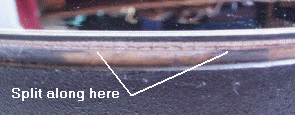 kerfing it can be replaced, the soundboard can not be easly replaced nor the guitar sides. If we split the kerfing carfully when we re fit the soundboard it will fit like a jigsaw piece. This is a easy process until you come to the bottom. A 1 x 1 x 4 inch wooden block sits here to strenghten this area where the guitar usally rest on the ground. With the rest of the body loose you can split this with a very sharp chisel. Work along the block bit by bit, making very shallow cuts the width of your chisel. Make sure the shamfer of the chisel is towards the body, not the sound board, otherwise it wil bend the soundboard. After several passes (be patient) the block should split. Alternatively you can slip a fine saw in and cut through it, this will then require filler when you reassemble as the sawing will remove wood.
kerfing it can be replaced, the soundboard can not be easly replaced nor the guitar sides. If we split the kerfing carfully when we re fit the soundboard it will fit like a jigsaw piece. This is a easy process until you come to the bottom. A 1 x 1 x 4 inch wooden block sits here to strenghten this area where the guitar usally rest on the ground. With the rest of the body loose you can split this with a very sharp chisel. Work along the block bit by bit, making very shallow cuts the width of your chisel. Make sure the shamfer of the chisel is towards the body, not the sound board, otherwise it wil bend the soundboard. After several passes (be patient) the block should split. Alternatively you can slip a fine saw in and cut through it, this will then require filler when you reassemble as the sawing will remove wood.
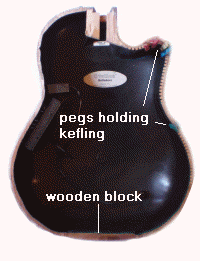
Now you have your guitar in pieces
Do not clean the joints up too much as any uneveness will help it fit back together, but do remove any loose splinters. also glue back onto the body any kefling that has fallen off. You can use clothes pegs to hold it in place.
Removing the Bracing
The next step was to remove the old bracing from the soundboard, this was x bracing and was as warped as the soundboard. This can be done with a sharp, thin knife blade slipped between the bracing and the soundboard. This is where we could see what the problem was.The middle of the x in the x bracing had never been glued to the guitar soundboard. The Ovation repair had simply glued the ends of the bracing back down. You can see where they glued it on the photo below, you can see where the glue ran.
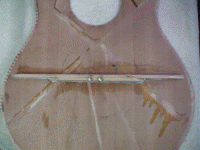
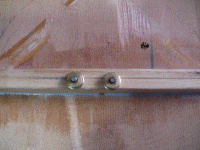
This guitar had always had feedback problems when amplified and an overbearing E. So we did not use X bracing when we replaced the bracing. We went for belt and braces approach and used cross bracing, double thick at the bridge area. We replaced the two screws that run through the bridge with 1.5 inch screws. We then ran them through the bracing below the bridge as well as the bridge. By tightning these screws we could staighten out the bow in the guitar soundboard. We glued the brace before tightening it up for the last time.
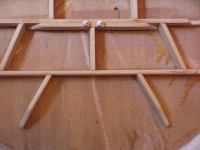
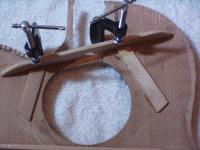
The Guitar Bracing
As we said this is belt and braces. The vertical and angled bracing above the bottom brace as well as the brace just below the sound hole are not needed in conventional guitar repair. This has the effect of reducing the low frequency resonance response, and in this case, the boomy bottom E and the feedback problem.
Putting the Guitar Back Together
Well none of our clamps were any good on a round back Balladeer. So when it came to gluing it back together we had to improvise. With the guitar resting on carefully laid cushions, to keep it flat and level we placed sand bags on various points on the soundboard, also latts placed over the soundboard had sand bags hung on each end to make sure we got a good joint back to the body.
Fitting the Guitar Neck
The soundboard on and allowed to dry ( 24 hours), next job was to re-fit the neck ( We will find out how the guitar plays and sounds before doing any further time consuming work.). The neck should drop into the dovetail cutaway easly, getting tighter towards the bottom. Check that the two bolts will screw into thier respective holes in the neck joint. If they do not line up, work the joint tighter until they do. When the neck is in the right place, the bolts should fit easily. We left the guitar another 24 hours to dry and settle. The next day we strung the Balladeer up. The sound board was a little flatter than before, so the bridge was lower. We shimmed the bridge saddle until it played without buzzes. Once we had the strings up to tension we adJusted the truss rod. We will finish off the body/soundboard joint and fit the binding when we are happy everything is OK.
Three Weeks Later
The guitar played well from the start but took a couple of weeks to settle. By week three the sound board had regained a gentle curve and the tone had more or less returned to how it was before the disaster. I felt it was good enough to take to a jam and it performed great, cutting through the other acoustic guitars just like an Ovation should.
Amplified, the guitar performed better than before, the boomy E was no more. Now all I have to do is tear myself away from it long enough to remove the neck and apply the binding.